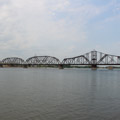The Chicago and North Western (C&NW) Railroad Bridge, constructed in 1906–1907, was one of the first rail bridges to span the Missouri River in South Dakota, linking Pierre (Hughes County) and Fort Pierre (Stanley County) on either side of the river, and more broadly, connecting eastern South Dakota, Minnesota, and the upper Midwest to western part of the state. Indeed, the C&NW played a crucial role in the settlement of western South Dakota. Although the eastern part of the state had railroad service by the late nineteenth century, there were few lines in the west, where most of the land was closed to white settlement. By the early twentieth century, however, the government reduced the size of Native American reservations, opening the land for white settlement, and the C&NW quickly began laying tracks to Rapid City, the gateway to the Black Hills.
This bridge was South Dakota’s first permanent river crossing over the Missouri River. Measuring approximately 2,200 feet in length and 20 feet wide, the bridge consists of five pin-connected Pennsylvania through-truss spans, one of which was fitted as a swing span. The Pennsylvania truss was desirable for long spans carrying heavy loads. The four non-swing spans are each 350 feet long, while the swing span is 445 feet long. The Pennsylvania Steel Company fabricated and installed the superstructure, which rests on massive piers faced with ashlar granite from Ortonville, Minnesota; this substructure was built by Arthur McMullen and Company of New York City. The original approaches included timber trestles, but these were replaced in the 1920s with plate-deck girder structures fabricated by the Lassig Bridge and Iron Works of Chicago, Illinois. By the time of the bridge’s completion, the swing span, which was mandated by federal navigation laws, was rarely used since commercial riverboat traffic on this part of the Missouri River was virtually over. The swing span is no longer functional but the bridge has seen continuous rail service since its construction.

















